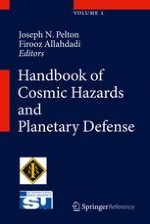2015 | OriginalPaper | Chapter
Active Orbital Debris Removal and the Sustainability of Space
Authors : Joyeeta Chatterjee, Joseph N. Pelton, Firooz Allahdadi
Published in: Handbook of Cosmic Hazards and Planetary Defense
Publisher: Springer International Publishing
Activate our intelligent search to find suitable subject content or patents.
Select sections of text to find matching patents with Artificial Intelligence. powered by
Select sections of text to find additional relevant content using AI-assisted search. powered by
